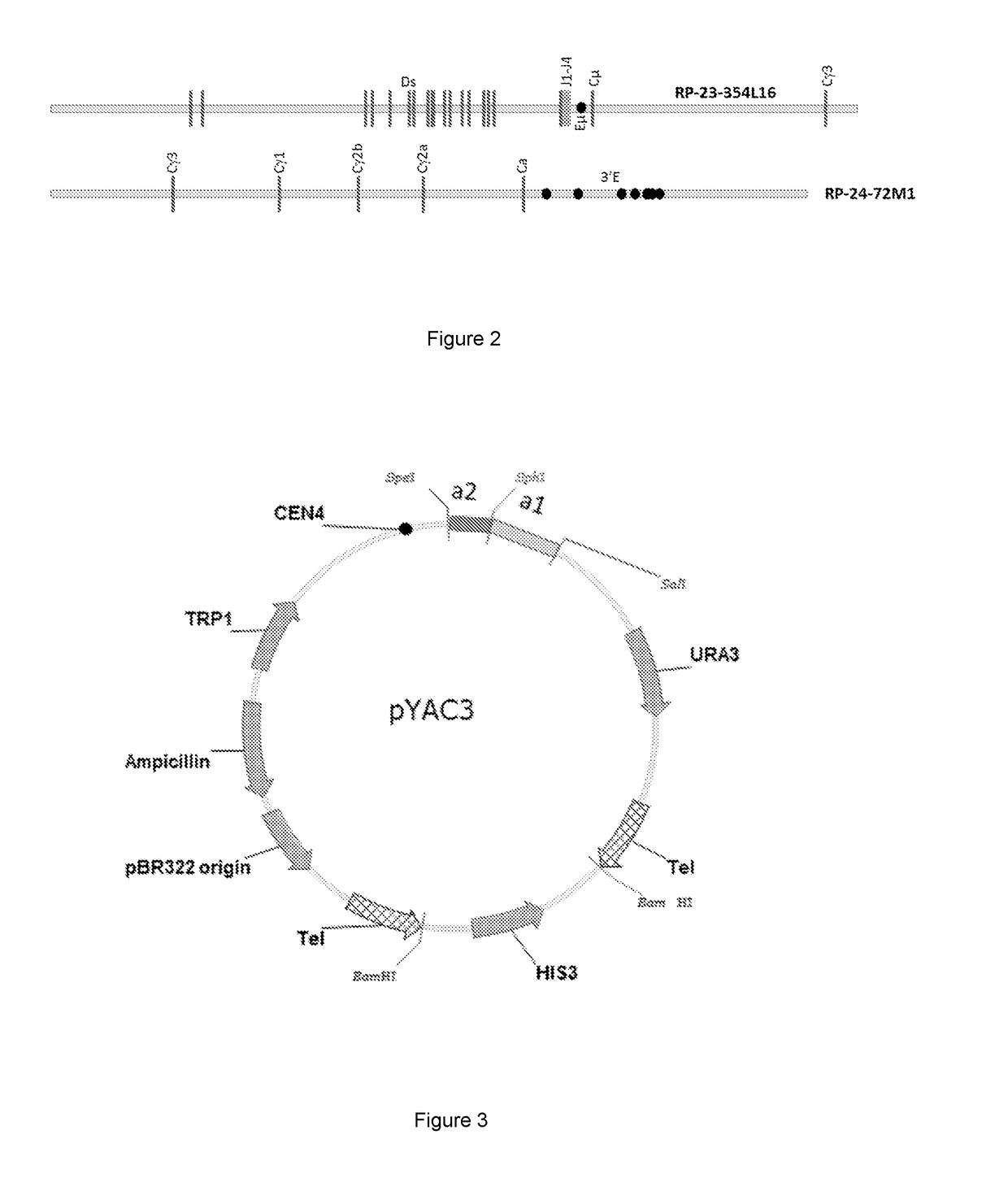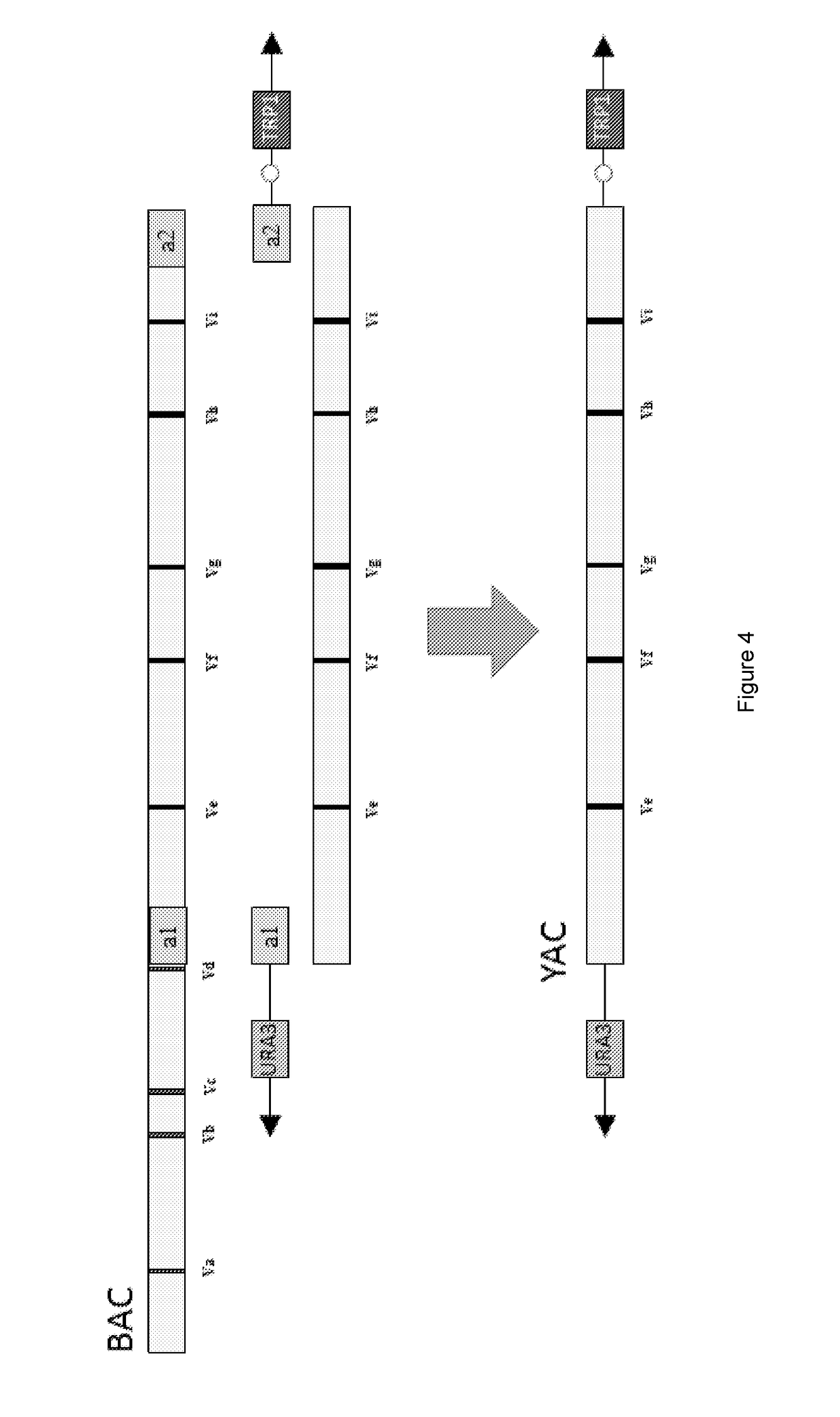Transgenic mice
- Summary
- Abstract
- Description
- Claims
- Application Information
AI Technical Summary
Benefits of technology
Problems solved by technology
Method used
Image
Examples
example 1
ion of YACs
[0194]1.1 Materials
[0195]Vectors:
[0196]pYAC3 (from Bruschi, ICGEB, Yeast Molecular Genetics Group, Trieste, ITALY)
[0197]pYNOT (derived from pYAC3 by replacing the URA3 with LEU2 marker. From Bruschi,
[0198]ICGEB, Yeast Molecular Genetics Group, Trieste, ITALY)
[0199]pHTK (derived from pYNOT by replacing the LEU2 with HIS3 marker)
[0200]pHKT-Hy (a hygromycin (Hy) resistant gene inserted into pHKT)
[0201]pYES1L (Invitrogen)
[0202]Yeast Strains:
[0203]YLBW1 (Hamer et al., 1995), AB1380 (Markie, 2006).
[0204]1.2 Convert BACs to YACs
[0205]BACs (bacterial artificial chromosomes in a circular format) are tools well known in the art that facilitate the manipulation (e.g. sequencing and cloning) of segments of DNA from ˜150 kbp-350 kbp in size (Methods in Molecular Biology, Volume 54 and 349). BACs containing DNA derived from the heavy chain immunoglobulin locus of humans or mice are numerous and well known in the art. Examples of such BACs (also listed in figs 1 and 2) include but are n...
example 2
n of Knockout Mice
[0262]The methods used to silence the mouse heavy chain locus (WO2004 / 076618+Ren, L., et al., Genomics 84 (2004), 686-695), the mouse lambda locus (Zou, X., et al., EJI, 1995, 25, 2154-2162 and WO2003 / 000737) and the kappa locus (Zou, X., et al., JI 2003 170, 1354-1361 and WO2003 / 000737) have been described previously. Briefly, large scale deletions of the mouse heavy chain constant region and the mouse lambda chain locus resulted in silencing of these two immunoglobulin chains. The kappa light chain was silenced via a targeted insertion of a neomycin resistant cassette.
[0263]a) Cross-Breeding of Heavy and Light Chain KO Mice
[0264]Mice with dual silencing of the endogenous light chains (kappa and lambda) were created by conventional breeding (Zou, X., et al., JI 2003 170, 1354-1361). These light chain-KO mice were further bred with heavy chain KO mice to give triple heterozygous animals for breeding to derive a triple knockout (TKO) line. This line proved to be fer...
example 3
sis
[0292]a) Pronuclear Microinjection
[0293]The technique of pronuclear microinjection of DNA to create transgenic animals is well described (eg see K. Becker & B. Jerchow “Generation of Transgenic Mice by Pronuclear Microinjection” pp 99-115 in “Advanced Protocols for Animal Transgenesis. An ISTT Manual. Ed. Shirley Pease & Thomas L. Saunders. Springer Protocols 2011). Briefly, fertilised oocytes are isolated from superovulated female mice that have been mated with a stud male. To give superovulation, females are injected intraperitoneally at day −2 with 100 ul of PBS containing 5 I.U. of pregnant mare's serum gonagotropin (PMSG). After 46-48 hours, 5 I.U. of human chorion gonadotropin (hCG) in 100 ul of PBS is administered (i.p.) and the females are mated with the stud males. The following morning, cumulus complexes are harvested from collected oviducts and oocytes released by digestion with hyaluronidase solution. Various strains of mice can be successfully employed for producing ...
PUM
 Login to View More
Login to View More Abstract
Description
Claims
Application Information
 Login to View More
Login to View More - R&D
- Intellectual Property
- Life Sciences
- Materials
- Tech Scout
- Unparalleled Data Quality
- Higher Quality Content
- 60% Fewer Hallucinations
Browse by: Latest US Patents, China's latest patents, Technical Efficacy Thesaurus, Application Domain, Technology Topic, Popular Technical Reports.
© 2025 PatSnap. All rights reserved.Legal|Privacy policy|Modern Slavery Act Transparency Statement|Sitemap|About US| Contact US: help@patsnap.com



